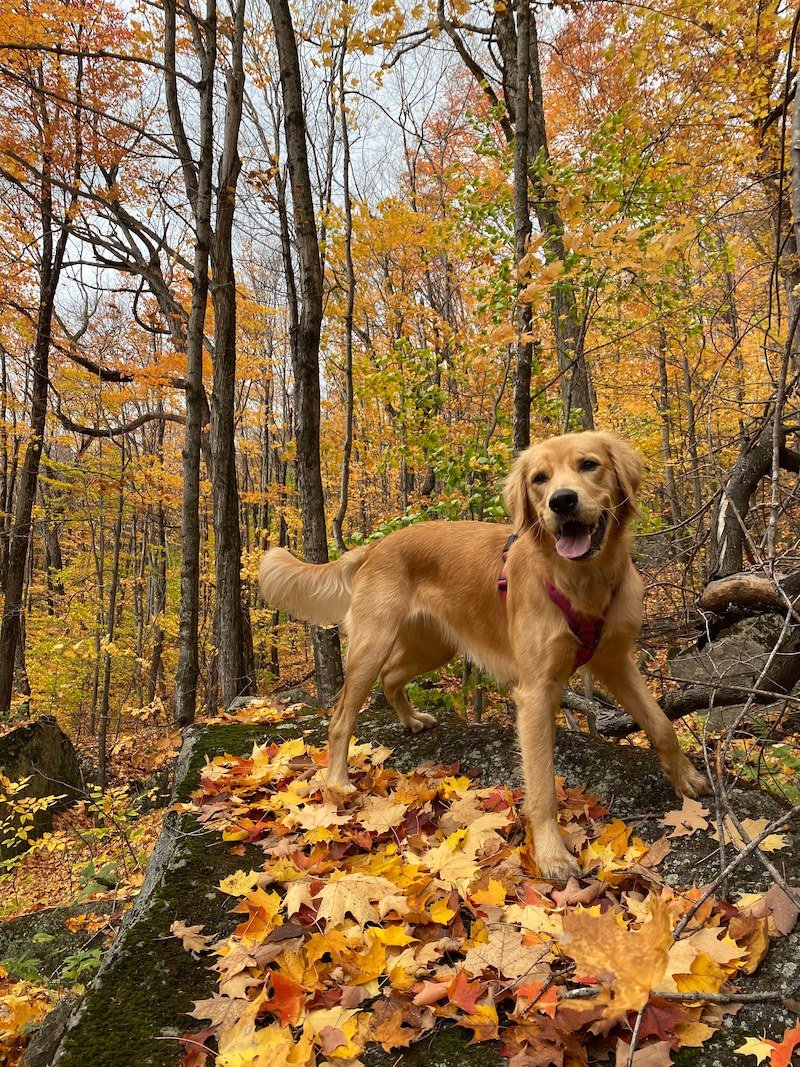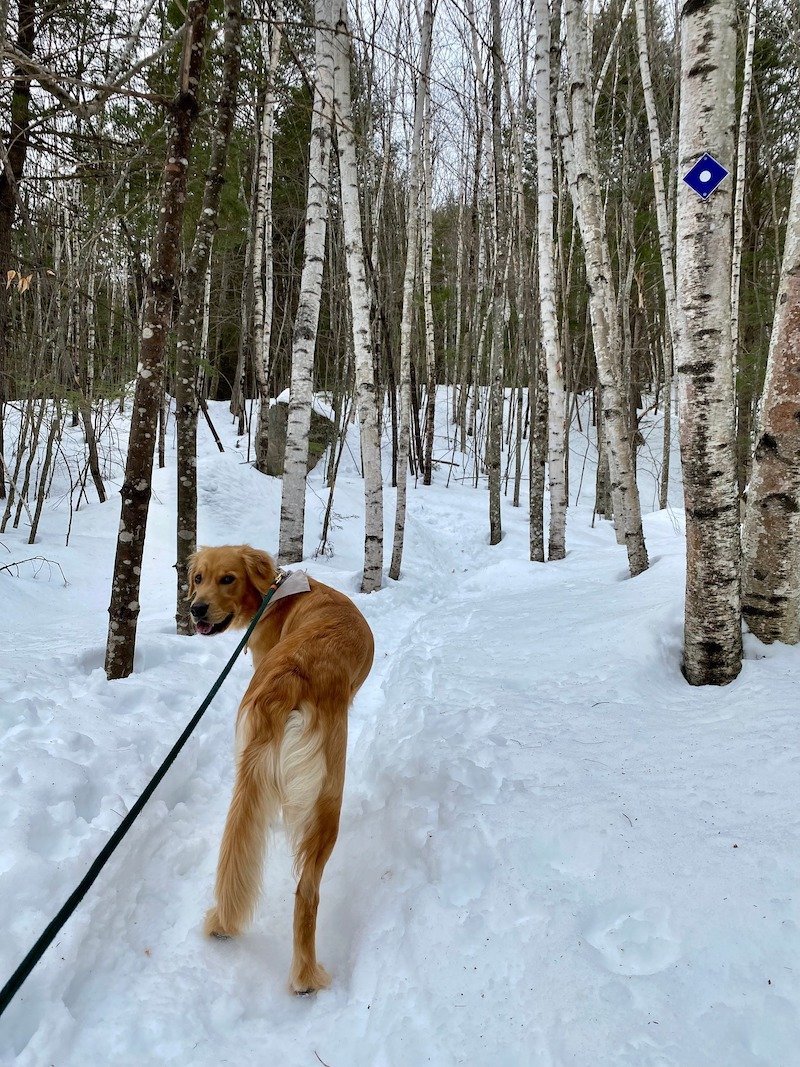Getting on trails with dogs
I would call it a type of magic – hiking with your best friend, exploring new trails, and experiencing life together. One of my favorite ways to get outside and adventure is with my golden retriever, Atlantic. We love to go camping, running, and swimming together, but our favorite way to spend time outside is hiking. The first time I was able to get on trail with her, it was one of the most joyous moments. It felt so freeing. That feeling is addicting – and I know that I am not the only one who feels this way! Within the Women Who Explore community, there are many women who also love to get outside with their dogs.
In 2021, I ventured out solo hiking with Atlantic for the first time. She was just a tiny puppy and ever since that first day, we have been learning as we go. I want to share some of these stories, and what I have learned so that someone else can learn from them and enjoy journeys with their little ones! Adventuring with a dog makes everything more fun and exciting, but it also adds another layer of preparation. Everything that we as humans need, your dog is likely to need as well! This post provides a brief overview of some necessary items to cover before your next pup-friendly adventure including researching ahead of time, types of gear to think about, items to think about on trail, and post-hike recovery.
Research/Preparation
I love to do a little research before I hit the trail. This helps me to determine if dogs are allowed, what the leash laws are, and if there are any difficult areas of the trail that may pose a problem for my dog – maybe they are too small for a scrambling area, or too big to make it through a tight section. If dogs are allowed, then great! If they are not allowed, there is probably a good reason as to why – environment, safety, etc. I think it’s best to follow these rules, even though it may be a bummer at times. Be aware of the rules surrounding leash laws on the trail you plan to take. Some areas may fine a pet owner for not obeying these rules and regulations, and it is important to know about this ahead of time! As a final step, I would always suggest doing a little extra research on more difficult trails that do allow dogs: read the reviews on trail applications, ask park rangers or friends, or do a Google search. This will help you determine if your dog can safely complete the trail and if they may need special gear to do so.
Last fall, my pup and I headed up to a small mountain in western Maine. I remember how vivid the leaves were – It was incredible! I had read about the trail ahead of time: dog friendly but with a section containing a small ladder that might cause some difficulty for larger dogs. We had a blast hiking along until we hit a small rocky section that Atlantic would simply not pass. I had brought a special harness along with a handle to help carry her, but it turned out to be unsafe to attempt alone. In the end, we had to turn around early, and it was totally fine! Knowing when to turn around is something respected in the mountains. Our day was still wonderful. Ultimately, my research had served me well – I was aware that we may have to turn around at some point (even though this was earlier than expected), and I was able to take that into account while I experienced an obstacle on trail.
Dogs need gear, too!
Dogs need gear, too. While they may not be wearing sunglasses, there are other essentials that they may need, depending on the trail difficulty/technicality. Some of the essentials on any hike include a collapsible water bowl, water, treats and food, a sturdy leash (often a 6’ leash is recommended), a hiking harness, and a first aid kit for pups. Enough water for both of you is vitally important! You can carry this in your pack, or you can opt to have your dog carry their own gear in a dog pack. Some other items that you may need include paw protection and/or a dog coat, depending on the weather and your particular dog breed.
One instance in my life where extra gear may have come in handy occurred last year in New Hampshire where Atlantic and I had prepared to hike Mount Washington. I visited the trailhead a few days ahead of time to speak with a trail volunteer about hiking with a dog – he informed me that dogs were more than welcome, as did the AllTrails app. During the hike, I was approached by multiple people asking me if her paws were okay and telling me that it was fine to turn around early if need be. Of course, I was keeping on top of all of these little details, but this was the first trail where people were so concerned about her and her well-being. Further up the mountain, I ran into a trail keeper, and he laughed when I told him that I had been told the trail was dog friendly. So, even with the due diligence that I had put in ahead of time, it turned out that the trail was not the most dog-friendly, and I could have used a bit more gear to prepare ahead, such as paw salve or booties, due to the harsh and abrasive rocks in the area.
Situational Awareness
On trail, I am always aware of my surroundings. This means that I am cautious about who is near me, the plants in the area, the weather, other dogs nearby, and of course – where my dog is located. All these little details add up, but over time and with experience, they become second nature. The mountains can become dangerous in the blink of an eye! Some dogs are notorious for eating anything and everything. Some plants are poisonous for dogs, so be aware of this – the last thing anyone wants is to have to carry their 40- or 60- or 90-lb dog down a trail in an emergency. Owners can prepare for this by keeping dogs leashed or keeping a keen eye on them while hiking. Something else to be aware of on trail is other animals. It is always a good idea to understand your dog’s behavior and how they will react to other creatures they may encounter – whether this is another person’s pet or a wild animal. It is totally okay to speak up about your pet. If you do not want every hiker passing by to pet your dog, tell them. Whatever works best for you is best!
Even though Atlantic and I adventure on the trails all the time now, and she is pretty darn good at obeying and staying with me, but she is still young. Recently, we were doing a long training hike in Tennessee. We had been on trail for several hours, both exhausted, and about to hit the trailhead back toward the campground when she darted off trail, likely chasing an animal. I immediately became worried because this is abnormal behavior for her. After an hour of searching, speaking with every person at the campground, and freaking out a bit, we found each other. She acted like she hadn’t seen me in a year!
Post-Adventure Recovery
After the hike is super important for your dog, just like it is for you, although, this is probably the easiest part! They need to recharge with water, food, and rest. Try to give your dog water and a snack once you get back to your car to begin their recovery process. Once you get home, they may need extra food for dinner after burning so many calories. Watch your dog to be sure that they are recovering properly. Then, everyone can snuggle up and take a well-deserved nap!
So, before you hit the trails again, be sure to think of your little one ahead of time. There is always something new to learn, and I hope that this short list will get you started. There really is nothing like the bond that is created as you begin to adventure with your dog!
So, what trail will you hit next?
Written by Laurel O’Donnell for Women Who Explore








